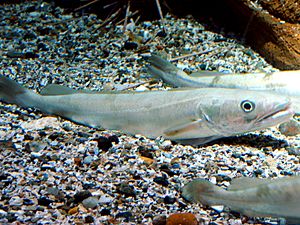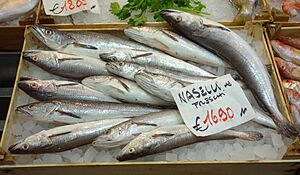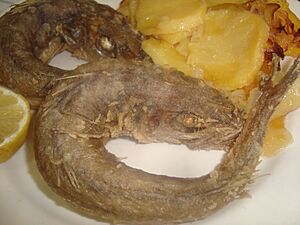European hake facts for kids
Quick facts for kids European hake |
|
|---|---|
 |
|
| Conservation status | |
| Scientific classification | |
 |
|
| Synonyms | |
|
The European hake (scientific name: Merluccius merluccius) is a type of fish found in the ocean. Some people also call it the Cornish salmon or herring hake. It's a hunter fish that often gets caught in nets with Atlantic herring, which it likes to eat. That's why it's sometimes called the "herring hake."
You can find the European hake in the eastern Atlantic Ocean. Its home ranges from Norway and Iceland in the north, all the way south to Mauritania. It also lives in the Mediterranean Sea. This fish is very important for fishing in Europe. However, some groups of hake are being caught too much, which means their numbers might not be able to grow back fast enough.
Contents
What Does a European Hake Look Like?
The European hake has a long, thin body. It has a big head and large jaws with many curved teeth. The lower jaw has two rows of teeth, and the upper jaw has one. The inside of its mouth and gill area are black.
It has two dorsal fins on its back. The first dorsal fin is shaped like a triangle and is tall. The second dorsal fin is long, almost the same length as the fin on its belly, called the anal fin. The tips of its pectoral fins (side fins) reach its anal fin when it's young. Its tail fin, called the caudal fin, is strong and has a straight edge.
The hake's lateral line (a sensory line along its side) is straight and darker than its body color. Its back is blue-grey, its sides are silvery, and its belly is whitish. These fish can grow up to 180 cm (71 in) long, but this is rare. Most large hake are around 100 cm (39 in) long.
Where Do European Hake Live?
European hake live in the eastern Atlantic Ocean. They are found from Norway and Iceland, south along the European coast to the Straits of Gibraltar. They also live south along the west coast of Africa to Mauritania.
You can also find them in the Mediterranean Sea. They even go into the Black Sea, but only along its southern shores. In the Baltic Sea, they usually don't go further east than the Kattegat. However, they have been seen as far east as Lithuania.
Habitat and Life Cycle
European hake usually live in waters between 70 m (230 ft) and 370 m (1,210 ft) deep. But they can be found in shallower waters, as shallow as 30 m (98 ft), or much deeper, up to 1,000 m (3,300 ft). During the day, they stay close to the seabed. At night, they become more active and swim higher up in the water.
Reproduction and Growth
European hake have a very long spawning period, which means they lay eggs for many months. The timing of spawning changes depending on where they live. In the Mediterranean Sea, it's from December to June. Off western Scotland, it's from May to August.
Female hake can lay eggs four or five times during one spawning season. They take breaks in between. Spawning usually happens in waters between 100 and 300 meters deep. Young hake live on muddy seabeds until they are about three years old. Then they move closer to the coast.
Most female hake become ready to breed when they are about seven years old and around 57 cm (22 in) long. Males mature earlier, at about five years old and 40 cm (16 in) long in the Atlantic. In the Mediterranean, males mature at 26–27 cm (10–11 in) and females at 36–40 cm (14–16 in). Females grow faster than males. A single female can lay between 2 million and 7 million eggs. European hake can live for up to 20 years.
The main areas where hake lay their eggs are in the southern parts of their range. This includes the canyons and rocky areas of the Bay of Biscay. The most eggs are laid at depths of about 200 m (660 ft). After about two months, the eggs hatch. Young hake stay near muddy bottoms during the day and swim up to feed at night. Adult hake also rest near the bottom during the day but don't swim as close to the surface as the young ones.
What Do European Hake Eat?
Small European hake, less than 16 cm (6.3 in) long (under one year old), mostly eat small crustaceans. These include tiny shrimp-like creatures such as krill, mysids, and amphipods. At this young age, they prefer deeper water.
As they grow, they start to eat more fish. They move to shallower areas. In the Adriatic Sea, their main food includes pilchards, European sprats, and European anchovys. They also eat Atlantic mackerel and Horse mackerel. Sometimes, they even eat smaller hake! Cephalopods (like squid) have also been found in their stomachs. In the north-east Atlantic, they eat blue whiting, horse mackerel, and other herring-like fish. They are considered top predators in these areas.
As hake get bigger, fish become even more important in their diet. Hake between 16 cm (6.3 in) and 35.9 cm (14.1 in) long mostly eat pilchards and anchovies. Once they reach about 36 cm (14 in) long, they eat only fish. Their favorite prey changes to fish like Spicara flexuosa and Centracanthus cirrus. They also eat some decapods (like shrimp). Larger hake have been known to eat smaller hake, with up to 71% of their diet being other hake.
Because they often eat herring-like fish, they were given the name "herring hake." This also means they are often caught in fishing nets along with herring.
European Hake and Fishing
The European hake is a very important fish for fishing in western Europe. Because it grows slowly and females mature at an older age, it can be easily overfished. This means too many fish are caught, and the population can't recover fast enough.
In 1955, over 160,000 tonnes of hake were caught. By 2000, this dropped to about 60,000 tonnes (66,000 short tons) tonnes. However, it went up again to nearly 100,000 tonnes (110,000 short tons) tonnes in 2009 and 2010.
There are two main groups of European hake in the Atlantic: a northern group and a southern group. The northern group seems to be doing better, and its population is growing. But the southern group and those in the Mediterranean are still being overfished. For example, in the Gulf of Lions, hake used to be a big part of the fish caught. But now, only young hake are found there because of too much fishing.
The main places where hake are caught are north and west of Scotland, west and south of Ireland, the Bay of Biscay, the coast of Portugal, and the west coast of North Africa.
Protecting European Hake
The northern group of European hake has recovered since new rules were put in place in 2001. Fishing is now controlled by limiting how much fishing can happen. There are also rules about the size of fish that can be caught and areas where fishing is not allowed. For example, in Turkey, hake must be at least 25 cm (9.8 in) long to be caught. In Morocco and the European Union, the minimum size is 20 cm (7.9 in).
Different groups have looked at the hake population. The hake in the Mediterranean Sea are considered Vulnerable (at risk). Those in the Baltic Sea are Near Threatened. But overall, the IUCN (International Union for Conservation of Nature) lists the European hake as "Least Concern." This is because the northern group has grown a lot. Its numbers increased five times in the five years leading up to 2015. While the southern group is still overfished a little, its numbers have also increased in the 10 years up to 2015.
European Hake as Food
European hake is often sold fresh, but it can also be frozen, dried, salted, or put in cans. The meat has a mild taste, which is softer than cod. It has a white, flaky texture. When raw, the meat is quite soft, but it becomes firm and meaty after it's cooked.
In France, this popular fish is called "colin" or sometimes "saumon blanc" (which means "white salmon"). It's also a favorite food fish in Iberia (Spain and Portugal). There, it's often grilled, pan-fried, or baked. Hake meat goes well with strong flavors. It's often cooked with tomatoes, garlic, chorizo (a type of sausage), and paprika.
A medium-sized hake, called pescadilla in Spanish, is sometimes served with its mouth biting its tail. This is called pescadilla de rosca. In Spanish, "La pescadilla que se muerde la cola" (the hake that bites its tail) is a saying for a problem that keeps going in circles.






